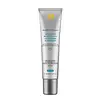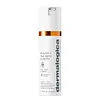What's inside
What's inside
 Key Ingredients
Key Ingredients

 Benefits
Benefits

 Concerns
Concerns

 Ingredients Side-by-side
Ingredients Side-by-side

Water
Skin ConditioningAlcohol Denat.
AntimicrobialEthylhexyl Triazone
UV AbsorberDrometrizole Trisiloxane
UV AbsorberIsononyl Isononanoate
EmollientIsopropyl Lauroyl Sarcosinate
Skin ConditioningButyl Methoxydibenzoylmethane
UV AbsorberDiisopropyl Sebacate
EmollientBis-Ethylhexyloxyphenol Methoxyphenyl Triazine
Skin ConditioningNiacinamide
SmoothingDimethicone
EmollientMethylene Bis-Benzotriazolyl Tetramethylbutylphenol
UV FilterOctocrylene
UV AbsorberPropanediol
SolventEthylhexyl Salicylate
UV AbsorberCetearyl Alcohol
EmollientSilica
AbrasiveTranexamic Acid
AstringentTocopherol
AntioxidantPhenoxyethanol
PreservativePEG-10 Dimethicone
Skin ConditioningCI 77891
Cosmetic ColorantPolyglyceryl-10 Laurate
Skin ConditioningSodium Stearoyl Glutamate
CleansingCaprylyl Glycol
EmollientButylene Glycol
HumectantCetearyl Glucoside
EmulsifyingMica
Cosmetic ColorantGlycerin
HumectantPEG-20
HumectantAmmonium Acryloyldimethyltaurate/Vp Copolymer
Trisodium Ethylenediamine Disuccinate
Carbomer
Emulsion StabilisingInulin Lauryl Carbamate
Emulsion StabilisingT-Butyl Alcohol
PerfumingWater, Alcohol Denat., Ethylhexyl Triazone, Drometrizole Trisiloxane, Isononyl Isononanoate, Isopropyl Lauroyl Sarcosinate, Butyl Methoxydibenzoylmethane, Diisopropyl Sebacate, Bis-Ethylhexyloxyphenol Methoxyphenyl Triazine, Niacinamide, Dimethicone, Methylene Bis-Benzotriazolyl Tetramethylbutylphenol, Octocrylene, Propanediol, Ethylhexyl Salicylate, Cetearyl Alcohol, Silica, Tranexamic Acid, Tocopherol, Phenoxyethanol, PEG-10 Dimethicone, CI 77891, Polyglyceryl-10 Laurate, Sodium Stearoyl Glutamate, Caprylyl Glycol, Butylene Glycol, Cetearyl Glucoside, Mica, Glycerin, PEG-20, Ammonium Acryloyldimethyltaurate/Vp Copolymer, Trisodium Ethylenediamine Disuccinate, Carbomer, Inulin Lauryl Carbamate, T-Butyl Alcohol
Butyl Methoxydibenzoylmethane 3%
UV AbsorberHomosalate 7%
Skin ConditioningEthylhexyl Salicylate 5%
UV AbsorberOctocrylene 10%
UV AbsorberWater
Skin ConditioningCarthamus Tinctorius Oleosomes
EmollientPropanediol
SolventButyloctyl Salicylate
Skin ConditioningBentonite
AbsorbentButylene Glycol
HumectantDibutyl Adipate
EmollientPolysorbate 80
EmulsifyingPhysalis Pubescens Fruit Juice
Skin ConditioningC12-15 Alkyl Benzoate
AntimicrobialDiethylhexyl 2,6-Naphthalate
EmollientVp/Eicosene Copolymer
Aminopropyl Ascorbyl Phosphate
AntioxidantHydroxyacetophenone
AntioxidantDipotassium Glycyrrhizate
HumectantGlycine Soja Oil
EmollientVerbascum Thapsus Extract
Skin ConditioningCitrus Nobilis Peel Oil
MaskingRicinus Communis Seed Oil
MaskingDaucus Carota Sativa Root Extract
Skin ConditioningCitrus Aurantium Dulcis Fruit Extract
MaskingCitrus Paradisi Fruit Extract
Skin ConditioningGlycerin
HumectantCitrus Aurantifolia Oil
CleansingTocopherol
AntioxidantHydrogenated Lecithin
EmulsifyingAcrylates/C10-30 Alkyl Acrylate Crosspolymer
Emulsion StabilisingAllantoin
Skin ConditioningAscorbyl Methylsilanol Pectinate
AntioxidantBeta-Carotene
Skin ConditioningCaprylic/Capric Triglyceride
MaskingBisabolol
MaskingGluconolactone
Skin ConditioningLecithin
EmollientBoron Nitride
AbsorbentXanthan Gum
EmulsifyingMethylpropanediol
SolventSilica
AbrasiveSodium Stearoyl Glutamate
CleansingPotassium Cetyl Phosphate
EmulsifyingTetrahydroxypropyl Ethylenediamine
Trisodium Ethylenediamine Disuccinate
Citric Acid
BufferingSodium Hydroxide
BufferingSodium Acrylates Copolymer
Sodium Benzoate
MaskingPotassium Sorbate
PreservativeLimonene
PerfumingCitrus Species Peel Extract
PerfumingButyl Methoxydibenzoylmethane 3%, Homosalate 7%, Ethylhexyl Salicylate 5%, Octocrylene 10%, Water, Carthamus Tinctorius Oleosomes, Propanediol, Butyloctyl Salicylate, Bentonite, Butylene Glycol, Dibutyl Adipate, Polysorbate 80, Physalis Pubescens Fruit Juice, C12-15 Alkyl Benzoate, Diethylhexyl 2,6-Naphthalate, Vp/Eicosene Copolymer, Aminopropyl Ascorbyl Phosphate, Hydroxyacetophenone, Dipotassium Glycyrrhizate, Glycine Soja Oil, Verbascum Thapsus Extract, Citrus Nobilis Peel Oil, Ricinus Communis Seed Oil, Daucus Carota Sativa Root Extract, Citrus Aurantium Dulcis Fruit Extract, Citrus Paradisi Fruit Extract, Glycerin, Citrus Aurantifolia Oil, Tocopherol, Hydrogenated Lecithin, Acrylates/C10-30 Alkyl Acrylate Crosspolymer, Allantoin, Ascorbyl Methylsilanol Pectinate, Beta-Carotene, Caprylic/Capric Triglyceride, Bisabolol, Gluconolactone, Lecithin, Boron Nitride, Xanthan Gum, Methylpropanediol, Silica, Sodium Stearoyl Glutamate, Potassium Cetyl Phosphate, Tetrahydroxypropyl Ethylenediamine, Trisodium Ethylenediamine Disuccinate, Citric Acid, Sodium Hydroxide, Sodium Acrylates Copolymer, Sodium Benzoate, Potassium Sorbate, Limonene, Citrus Species Peel Extract
Ingredients Explained
These ingredients are found in both products.
Ingredients higher up in an ingredient list are typically present in a larger amount.
Also known as Avobenzone, this ingredient is a chemical sunscreen filter that provides protection in the UV-A range.
Avobenzone is globally approved and is the most commonly used UV-A filter in the world.
Studies have found that avobenzone becomes ineffective when exposed to UV light (it is not photostable; meaning that it breaks down in sunlight). Because of this, formulations that include avobenzone will usually contain stabilizers such as octocrylene.
However, some modern formulations (looking at you, EU!) are able to stabilize avobenzone by coating the molecules.
Avobenzone does not protect against the UV-B range, so it's important to check that the sunscreen you're using contains other UV filters that do!
The highest concentration of avobenzone permitted is 3% in the US, and 5% in the EU.
Learn more about Butyl MethoxydibenzoylmethaneButylene Glycol (or BG) is used within cosmetic products for a few different reasons:
Overall, Butylene Glycol is a safe and well-rounded ingredient that works well with other ingredients.
Though this ingredient works well with most skin types, some people with sensitive skin may experience a reaction such as allergic rashes, closed comedones, or itchiness.
Learn more about Butylene GlycolEthylhexyl Salicylate is an organic compound used to block UV rays. It primarily absorbs UVB rays but offers a small amount of UVA protection as well.
Commonly found in sunscreens, Ethylhexyl Salicylate is created from salicylic acid and 2-ethylhexanol. You might know salicylic acid as the effective acne fighter ingredient and BHA.
The ethylhexanol in this ingredient is a fatty alcohol and helps hydrate your skin, similar to oils. It is an emollient, which means it traps moisture into the skin.
According to manufacturers, Ethylhexyl Salicylate absorbs UV wavelength of 295-315 nm, with a peak absorption at 307-310 nm. UVA rays are linked to long term skin damage, such as hyperpigmentation. UVB rays emit more energy and are capable of damaging our DNA. UVB rays cause sunburn.
Learn more about Ethylhexyl SalicylateGlycerin is already naturally found in your skin. It helps moisturize and protect your skin.
A study from 2016 found glycerin to be more effective as a humectant than AHAs and hyaluronic acid.
As a humectant, it helps the skin stay hydrated by pulling moisture to your skin. The low molecular weight of glycerin allows it to pull moisture into the deeper layers of your skin.
Hydrated skin improves your skin barrier; Your skin barrier helps protect against irritants and bacteria.
Glycerin has also been found to have antimicrobial and antiviral properties. Due to these properties, glycerin is often used in wound and burn treatments.
In cosmetics, glycerin is usually derived from plants such as soybean or palm. However, it can also be sourced from animals, such as tallow or animal fat.
This ingredient is organic, colorless, odorless, and non-toxic.
Glycerin is the name for this ingredient in American English. British English uses Glycerol/Glycerine.
Learn more about GlycerinOctocrylene protects skin from sun damage. It absorbs UV-B with peak absorption of 304 nm. It is a common sunscreen ingredient and often paired with avobenzone, a UVA filter. This is because octocrylene stabilizes other sunscreen ingredients by protecting them from degradation when exposed to sunlight. Octocrylene is a photostable ingredient and loses about 10% of SPF in 95 minutes.
Octocrylene also acts as an emollient, meaning it helps skin retain moisture and softens skin. It is oil-soluble and hydrophobic, enhancing water-resistant properties in a product.
Those who are using ketoprofen, a topical anti-inflammatory drug, may experience an allergic reaction when using octocrylene. It is best to speak with a healthcare professional about using sunscreens with octocrylene.
The EU allows a maximum of these concentrations:
Learn more about OctocrylenePropanediol is an all-star ingredient. It softens, hydrates, and smooths the skin.
It’s often used to:
Propanediol is not likely to cause sensitivity and considered safe to use. It is derived from corn or petroleum with a clear color and no scent.
Learn more about PropanediolSilica, also known as silicon dioxide, is a naturally occurring mineral. It is used as a fine, spherical, and porous powder in cosmetics.
Though it has exfoliant properties, the function of silica varies depending on the product.
The unique structure of silica enhances the spreadability and adds smoothness, making it a great texture enhancer.
It is also used as an active carrier, emulsifier, and mattifier due to its ability to absorb excess oil.
In some products, tiny microneedles called spicules are made from silica or hydrolyzed sponge. When you rub them in, they lightly polish away dead skin layers and enhance the penetration of active ingredients.
Learn more about SilicaSodium Stearoyl Glutamate is an emulsifier and helps condition the skin. It is amino acid-based.
In higher amounts, it may act as a cleansing agent.
Tocopherol (also known as Vitamin E) is a common antioxidant used to help protect the skin from free-radicals and strengthen the skin barrier. It's also fat soluble - this means our skin is great at absorbing it.
Vitamin E also helps keep your natural skin lipids healthy. Your lipid skin barrier naturally consists of lipids, ceramides, and fatty acids. Vitamin E offers extra protection for your skin’s lipid barrier, keeping your skin healthy and nourished.
Another benefit is a bit of UV protection. Vitamin E helps reduce the damage caused by UVB rays. (It should not replace your sunscreen). Combining it with Vitamin C can decrease sunburned cells and hyperpigmentation after UV exposure.
You might have noticed Vitamin E + C often paired together. This is because it is great at stabilizing Vitamin C. Using the two together helps increase the effectiveness of both ingredients.
There are often claims that Vitamin E can reduce/prevent scarring, but these claims haven't been confirmed by scientific research.
Learn more about TocopherolTrisodium Ethylenediamine Disuccinate is used to help stabilize a product.
It is a chelating agent, meaning it helps prevent metal ions from binding to other ingredients. This prevents unwanted reactions in products. Metal ions can come into a product via the water ingredient. They are found in trace amounts and are not known to be harmful.
Water. It's the most common cosmetic ingredient of all. You'll usually see it at the top of ingredient lists, meaning that it makes up the largest part of the product.
So why is it so popular? Water most often acts as a solvent - this means that it helps dissolve other ingredients into the formulation.
You'll also recognize water as that liquid we all need to stay alive. If you see this, drink a glass of water. Stay hydrated!
Learn more about Water